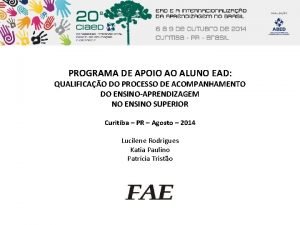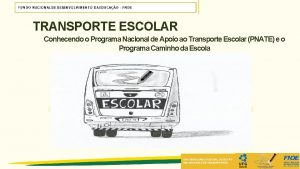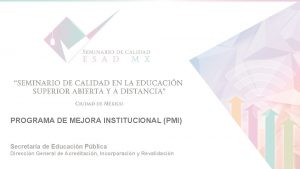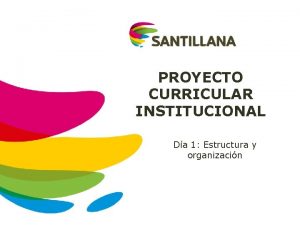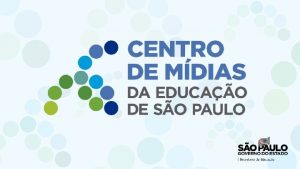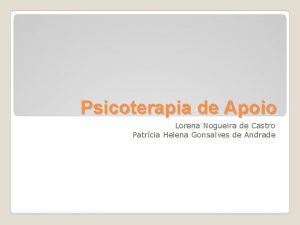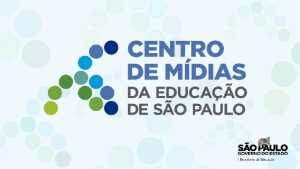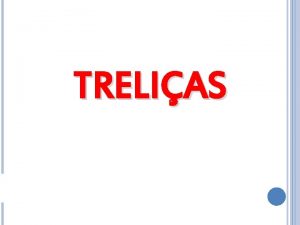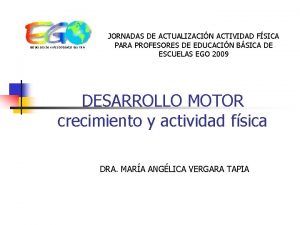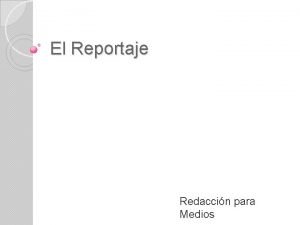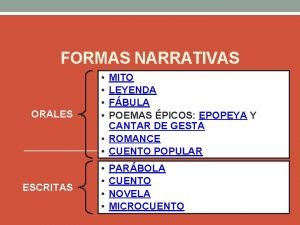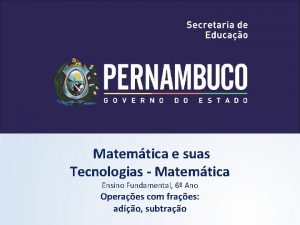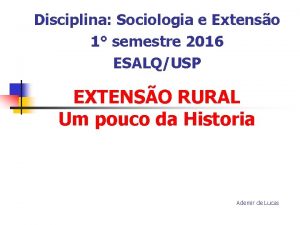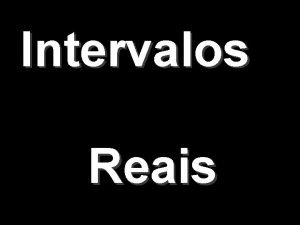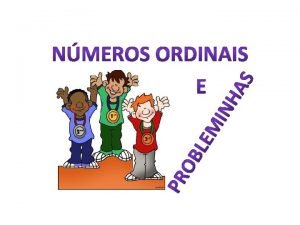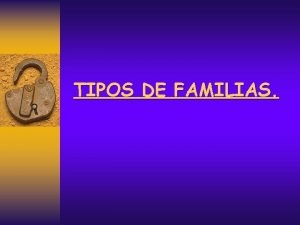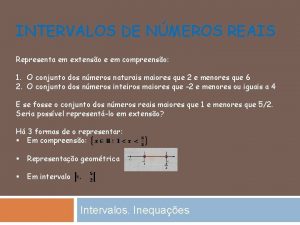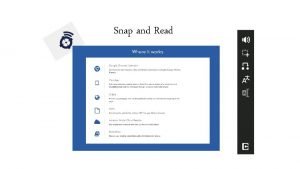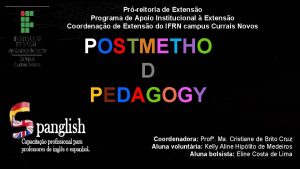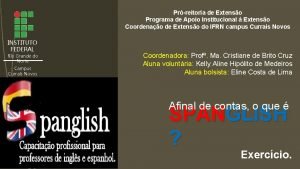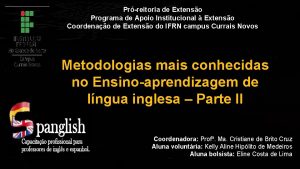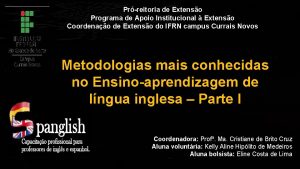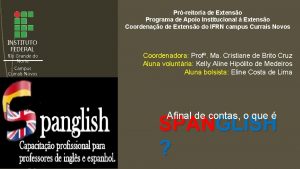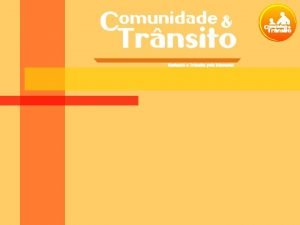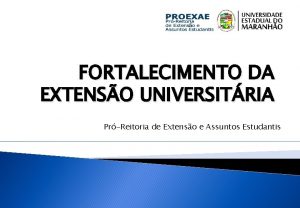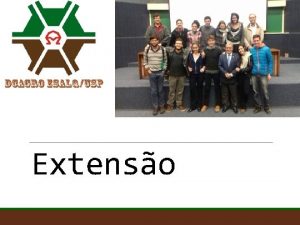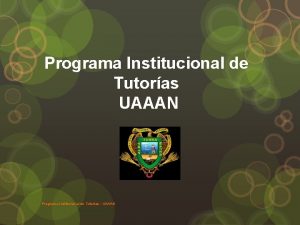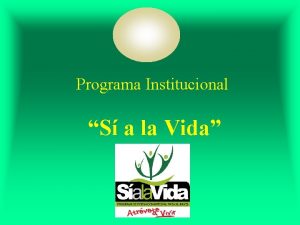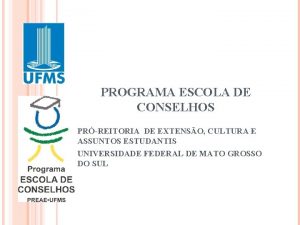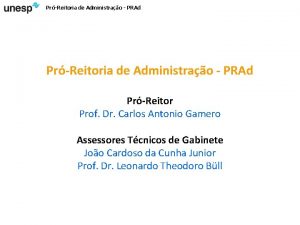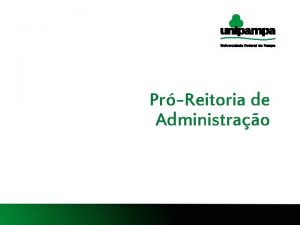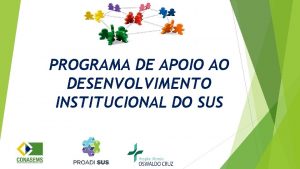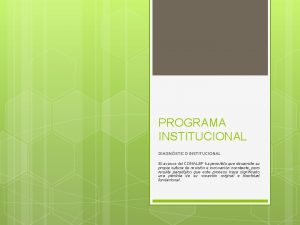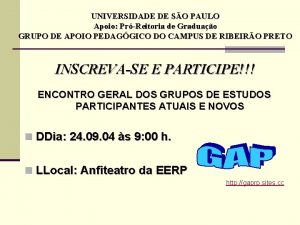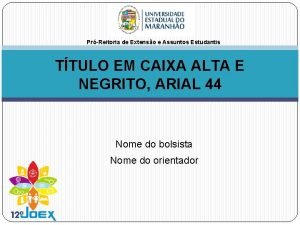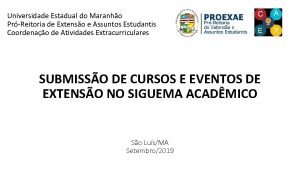Prreitoria de Extenso Programa de Apoio Institucional Extenso












![RAI S I NG CUL T URAL CONS(1993) CIO[…] USL 2 Nclassroom ESS as RAI S I NG CUL T URAL CONS(1993) CIO[…] USL 2 Nclassroom ESS as](https://slidetodoc.com/presentation_image_h2/1244f405bb4334db0f124eb4296413f1/image-13.jpg)



![CRI T I CAL CUL T URAL […] unmistakable raising critical cultural consciousness in CRI T I CAL CUL T URAL […] unmistakable raising critical cultural consciousness in](https://slidetodoc.com/presentation_image_h2/1244f405bb4334db0f124eb4296413f1/image-17.jpg)






- Slides: 23

Pró-reitoria de Extensão Programa de Apoio Institucional à Extensão Coordenação de Extensão do IFRN campus Currais Novos P O S T ME T H O D P E DAG O G Y Coordenadora: Profª. Ma. Cristiane de Brito Cruz Aluna voluntária: Kelly Aline Hipólito de Medeiros Aluna bolsista: Eline Costa de Lima

About the class. . . P O S T ME T H O D KUMARAVADIVELU, B. A (2003). Beyond Methods: P E D G O G Y Macrostrategies for Language Teaching. Yale University Press New Haven and London.

REVIEW Difficulties on Traditional Methods: Concept; Use; Maintenance; Procedures, activities; efficacy; Methods have: “interested knowledge” that plays an important role in preserving and promoting inequities; “anti-methods pedagogy” - critical understanding of the sociocultural context that guides our practices so as to free us from them. Postmethod condition attributes – alternative; autonomy; principled pragamatism. Postmethod parameters – Particularity; Practicality (theory/practice); Possibility (critical pedagogy). Macroestrategies (11) Ensuring social relevance; Raising cultural consciousness;

REVIEW Ensuring social relevance – Every classroom is influenced by and is a reflection of the larger society of which it is a part (the international, community, ethnic, bureaucratic, professional, political, religious, economic and family contexts in which schools are located and interact); Society – forms of accommodation and assistance as well as domination and resistance (class, gender, race, ethnicity, nationality, religion, language, and sexual orientation); Social Relevant Teaching – recognizing that the broader social, political, historical, and economic conditions affects the lives of learners, teachers and activities. Standart Variety of a Language – those who control the social, political, and cultural power centers; gets its prestige owing to social, political, and economic factors and not linguistic ones; Colonialism used language to political, social, and cultural control. Postcolonial theorists: colonial process itself begins in language. Not-standart – impure.

REVIEW The use of L 1 in ESL class – make the connection between the home language and the target language; Textbooks – are not neutral (represent cultural values, beliefs, and attitudes); the hidden cultural values; because of the global spread of English, ELT has become a global industry, textbook production has become very important. Pedagogy of possibility – concerned with individual as well as social identity; L 2 education provides its participants with challenges and opportunities for a continual quest for subjectivity and self-identity.

RAI S I NG CUL T URAL CONis. Sone CI O NEor. SS “Culture of U the. Stwo three most complicated words in the English language, ” says Raymond Williams (1976, p. 87), the author of Keywords: A Vocabulary of Culture and Society. Culture is such a complicated concept that it does not lend itself to a single definition or a simple description. It brings to mind different images to different people. In its broadest sense, it includes a wide variety of constructs such as the mental habits, personal prejudices, moral values, social customs, artistic achievements, and aesthetic preferences of particular societies.

RAI S I NG CUL T URAL Recognizing the. Camorphous CO NS IOUSNnature ESSof the concept of culture, anthropologists thought it fit to distinguish between Culture with a capital C and culture with a small c. Culture culture Societal construct The general view of culture as creative endeavors: Relatively personal construct Referring to the patterns of behavior, values, and beliefs theater, dance, music, literature, and art. that guide the everyday life of an individual or a group of individuals within a cultural community

RAI S I NG CUL T URAL CO NS CI O US NE S S Historically, the cultural orientation that informed L 2 learning and teaching was confined mostly to Culture with a big C. It is only after World War II, when language communication became the primary goal of language learning and teaching, that learners and teachers alike started emphasizing the importance of everyday aspects of cultural practices, that is, culture with a small c.

RAI S I NG CUL T URAL COobjective NS CI O USNteaching, ESS then, is to help L 2 learners develop The overall of culture the ability to use the target language in culturally appropriate ways for the specific purpose of empathizing and interacting with native speakers of the target language. […] Such an approach is based on a limited view of culture in at least two important ways. First, it narrowly associates cultural identity with national identity or linguistic identity. That is, it considers all the people belonging to a particular nation (e. g. , the United States) speaking a particular language (e. g. , English) as belonging to a particular culture. It ignores multicultural and subcultural variations within national or linguistic boundaries.

RAI S I NG CUL T URAL Second, the traditional approach to the teaching of culture also ignores the rich CO NS CI O US NE S S diversity of world views that learners bring with them to the language classroom. That is, even if a group of learners, as in most educational contexts, appear to belong to a seemingly homogeneous national or linguistic entity, their life values, life choices, life-styles, and, therefore, their world view may significantly vary. In that sense, most classes are not monocultural cocoons but rather are multicultural mosaics. Robinson (1985) talks about what she calls “cultural versatility, ” which implies “expanding one’s repertoire of experiences and behaviors, not subtracting anything” (1985, p. 101). When people expand their cultural repertoire, they “would become a little bit of ‘other, ’ and would have a degree of psychological match with more people” (p. 101).

RAI S I NG CUL T URAL Robinson (1991) CO NSCdevelops IOUSa. Ntheory ESSof second culture acquisition as the integration of home and target culture in a synthesis she refers to as the Color Purple. Her Color Purple is a productive, cognitive, perceptual, and affective space that results from meaningful cross-cultural contact. It is created when one becomes aware of one’s own cultural lens (i. e. , blue) and when one recognizes that a person from another culture has a different lens (i. e. , red). Neither person can escape his or her own cultural lens, but each can choose to overlap lenses (i. e. , purple) in order to understand better the other’s perspectives and arrive at shared meaning.

RAI S I NG CUL T URAL CO NS CI O US NE S S My cultu re The othe cultu r’s re
![RAI S I NG CUL T URAL CONS1993 CIO USL 2 Nclassroom ESS as RAI S I NG CUL T URAL CONS(1993) CIO[…] USL 2 Nclassroom ESS as](https://slidetodoc.com/presentation_image_h2/1244f405bb4334db0f124eb4296413f1/image-13.jpg)
RAI S I NG CUL T URAL CONS(1993) CIO[…] USL 2 Nclassroom ESS as a site of struggle between the Claire Kramsch learners’ meanings and those of native speakers […] “from the clash between the familiar meanings of the native culture and the unexpected meanings of the target culture, meanings that were taken for granted are suddenly questioned, challenged, problematized” (p. 238) Without seeking to blur the cultural boundaries between two different cultural communities, Kramsch would like teachers and learners to create what she calls “a third culture” in the L 2 classroom. She describes the third culture as a conceptual space that recognizes the L 2 classroom as the site of intersection of multiple worlds of discourse.

THIRD CULTURE – L 2 CLASSROOM MU L T I C U L T U R A L S P ACE

CRI T I CAL CUL T URAL Cit, Othe NS CIOUSof. Ncritical ESScultural consciousness requires the As I see development recognition of a simple truth: there is no one culture that embodies all and only the best of human experience; and, there is no one culture that embodies all and only the worst of human experience. Every cultural community has virtues to be proud of, and every cultural community has vices to be ashamed of. Developing critical cultural consciousness enables one to learn and grow, to change and evolve, so as to meet the challenges of today’s emerging global reality. Globalization (space, time, border) – economic and cultural; Internet – information, communication, electronic media;

CRI T I CAL CUL T URAL Cindividual ONSCneeds IOUmore SNthan ESanything S What the else to make proper use of that resource is a critically reflective mind that can tell the difference between information and disinformation, between ideas and ideologies. […] not only expands one’s cultural horizon but also clarifies and solidifies one’s own cultural heritage. This critical self-reflection helps one to identify and understand what is good and bad about one’s own culture, and what is good and bad about other cultures. […] In understanding other cultures, we understand our own better; in understanding our own, we understand other cultures better.
![CRI T I CAL CUL T URAL unmistakable raising critical cultural consciousness in CRI T I CAL CUL T URAL […] unmistakable raising critical cultural consciousness in](https://slidetodoc.com/presentation_image_h2/1244f405bb4334db0f124eb4296413f1/image-17.jpg)
CRI T I CAL CUL T URAL […] unmistakable raising critical cultural consciousness in the CONSCconclusion IOUSNabout ESS L 2 classroom: instead of privileging the teacher or the native speaker as the sole cultural informant, as the traditional approach to culture teaching would do, we need to treat the learner as a cultural informant as well. […] using the learners’ home language and culture to inform classroom activities enables students to become motivated and empowered. […] Such a process of cultural self-reflection and self-renewal is not confined to learners alone. In responding to their learners’ heightened cultural awareness, teachers are also challenged to reflect on their cultural selves as deeply as they expect their learners to do.

CRI T I CAL CUL T URAL C ON SCIOshould USNEmake SS a serious […] teachers attempt to access, respond, and build… LEARNERS’ VAST CULTURAL KNOWLEDGE + TARGET LANGUAGE COMMUNITY C. KNOWLEDGE GAIN A DEEPER UNDERSTANDIN G OF ALL. + THE WIDER WORLD C. KNOWLEDGE =

CRE AT I NG CRI T I CAL CUL T URAL CO NS CI O US NE S S LGBTQIA+: DESCUBRA AS NOVIDADES DA SIGLA: Sexualidade: sexo, gênero, orientação sexual e identidade de gênero : https: //www. youtube. com/watch? v=Xs. JTCKz. L-Gg Siglas: https: //www. youtube. com/watch? v=UQET 557 c. AKU; https: //www. youtube. com/watch? v=Jg 0 Bvhpt. Uj. I Casal de Transgêneros que namoram: https: //www. youtube. com/watch? v=5 xdy 40 Rx. EZI&t=110 s Pessoas não-binárias: https: //www. youtube. com/watch? v=NZj-9 rb. MVQE Pessoas assexuais: https: //www. youtube. com/watch? v=a-5 k 7 UAYsgc

CRE AT I NG CRI T I CAL CUL T URAL C O N S C I O U S N E S S LGBTQIA+: no-binary people, transgender, queer teaching, assexual people, etc. Queer teaching; LGBT invisibility in language learning materials; Heteronormativity. ENGLISH VIDEOS TO USE IN CLASS: Gender and Sexuality: https: //www. youtube. com/watch? v=mt. Yu. UL 3 Od. UY https: //www. youtube. com/watch? v=SEurl. Ky 2 b. N 0 Acronym: https: //www. youtube. com/watch? v=u. D_p 0 kkof-k Transgender: https: //www. youtube. com/watch? v=YQAFYy 15 N 7 E Non-binary: https: //www. youtube. com/watch? v=-7_ucz. Gw. JHQ Asexual people: https: //www. youtube. com/watch? v=i 14 YMp. KS_CY

CRE AT I NG CRI T I CAL CUL T URAL Black and Indian C O N S C I O U S N E S S people discussion: Racism and anti-racism; Decolonial pedagogy; Intersectionality, etc. Feminism: Feminist Pedagogy; Disabled people: Inclusive education. Blended learning, Computer-Assisted Language Learning (CALL), Mobile-Assisted Language Learning (MALL), Counceling Approach Controversities Approach Discourse Inquiring Approach

P RE S E NT AT I O N Queer teaching (LGBTQIA+) – Group 1 Anti-racist Pedagogy (BLACK PEOPLE) – Group 2 Decolonial Pedagogy (INDIGENOUS ISSUES) – Group 3 Feminist Pedagogy (WOMEN ISSUES) – Group 4 Pesquisar sobre as teorias e abordagens; Pesquisar textos e materiais; Utilizar técnicas, atividades e procedimentos de 2 dos métodos clássicos ou 2 macroestratégias (e suas microestratégias) da Teoria Pós-metodo (2 macroestratégias – 1 entre as duas que eu apresentei e outra de sua livre escolha – Kumaravadivelu (2003)) HISTÓRIAS REAIS DE PESSOAS TRANS: https: //www. youtube. com/watch? v=B 67 OVJTy. V 0 I PRETO E TRANS: https: //www. youtube. com/watch? v=lf. Nif. Qw 8 SL 8

Thank you very much! (84) 996 -087 -119 cristianebrito 1978@gmail. com https: //docente. ifrn. edu. br/cristianecruz/projetos-de-extensao/spanglish/
 Programa de apoio ao aluno
Programa de apoio ao aluno Programa nacional de apoio ao transporte escolar
Programa nacional de apoio ao transporte escolar Programa institucional de tecnovigilancia
Programa institucional de tecnovigilancia Programa de mejora institucional
Programa de mejora institucional Características del proyecto curricular institucional
Características del proyecto curricular institucional Materiais de apoio efape
Materiais de apoio efape Psicoterapia de apoio
Psicoterapia de apoio Escala de ashworth
Escala de ashworth Material de apoio efape
Material de apoio efape Elementos de apoio
Elementos de apoio Método das seções
Método das seções Com a trave no olho queremos limpar os olhos dos outros
Com a trave no olho queremos limpar os olhos dos outros Rolamento
Rolamento Relato informativo extenso
Relato informativo extenso Semejanzas entre mito y leyenda cuadro comparativo
Semejanzas entre mito y leyenda cuadro comparativo Fração 1/2 por extenso
Fração 1/2 por extenso 2016 extenso
2016 extenso Dado os intervalos reais abaixo represente os por extenso
Dado os intervalos reais abaixo represente os por extenso Googla chrome
Googla chrome Leia o texto e responda as perguntas abaixo
Leia o texto e responda as perguntas abaixo Terreno extenso, con extensa vegetación y fauna.
Terreno extenso, con extensa vegetación y fauna. Tipos de familia extendida
Tipos de familia extendida Dado os intervalos reais abaixo representa os por extenso
Dado os intervalos reais abaixo representa os por extenso Chrome extenso
Chrome extenso
